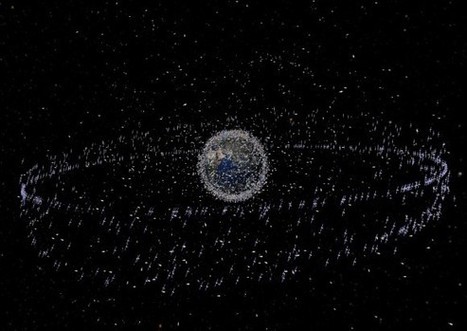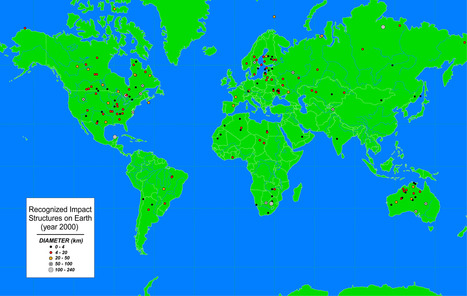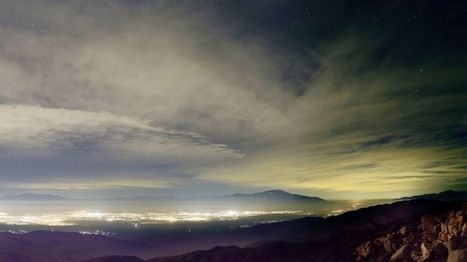 Your new post is loading...
COVID-19 has changed the way we live and work, as various health and safety restrictions keep more of us at home more often. The resulting changes to our behavior are already impacting the environment around us in myriad ways, according to comparisons of remote sensing data before and during the pandemic collected by NASA, U.S. Geological Survey (USGS), and ESA (European Space Agency) Earth-observing satellites and others. Researchers from several institutions presented their early results in a virtual press conference on Dec. 7 at the American Geophysical Union's 2020 fall meeting. They found that the environment is quickly changing, and the timing of those changes seems to indicate that the pandemic may be a reason. Deforestation rates are changing in some places, air pollution is diminishing, water quality is improving, and snow is becoming more reflective in some areas since the pandemic began earlier this year. "But we will need more research to clearly attribute environmental change to COVID," said Timothy Newman, National Land Imaging Program Coordinator for the United States Geological Survey (USGS). Scientists and engineers like Newman use remote sensing data to observe how the world is changing during the COVID-19 pandemic, comparing current remote sensing data to pre-pandemic trends. Newman's program monitors weekly changes with satellite images from the joint NASA/USGS Landsat satellites and the ESA's Sentinel-2 satellites. Newman's program observed that large swaths of the Brazilian Amazon rainforest were cleared from June to September of this year, since the start of the COVID-19 pandemic. Rapid deforestation also is occurring in the tropics near Indonesia and the Congo. Yet, in other parts of the Amazon rainforest such as Colombia and Peru, deforestation appears to have slowed somewhat since the onset of the pandemic.
A very nearby supernova could wipe all life off the face of Earth. But even farther away events may still leave their mark on the planet, new research suggests. Massive explosions of energy happening thousands of light-years from Earth may have left traces in our planet's biology and geology, according to new research by University of Colorado Boulder geoscientist Robert Brakenridge. The study, published this month in the International Journal of Astrobiology, probes the impacts of supernovas, some of the most violent events in the known universe. In the span of just a few months, a single one of these eruptions can release as much energy as the sun will during its entire lifetime. They're also bright -- really bright. "We see supernovas in other galaxies all the time," said Brakenridge, a senior research associate at the Institute of Arctic and Alpine Research (INSTAAR) at CU Boulder. "Through a telescope, a galaxy is a little misty spot. Then, all of a sudden, a star appears and may be as bright as the rest of the galaxy." A very nearby supernova could be capable of wiping human civilization off the face of the Earth. But even from farther away, these explosions may still take a toll, Brakenridge said, bathing our planet in dangerous radiation and damaging its protective ozone layer. To study those possible impacts, Brakenridge searched through the planet's tree ring records for the fingerprints of these distant, cosmic explosions. His findings suggest that relatively close supernovas could theoretically have triggered at least four disruptions to Earth's climate over the last 40,000 years. The results are far from conclusive, but they offer tantalizing hints that, when it comes to the stability of life on Earth, what happens in space doesn't always stay in space. "These are extreme events, and their potential effects seem to match tree ring records," Brakenridge said. Journal Reference: - G. Robert Brakenridge. Solar system exposure to supernova γ radiation. International Journal of Astrobiology, 2020; 1 DOI: 10.1017/S1473550420000348
Space junk, space debris, space waste — call it what you want, but just as junk and waste cause problems here on Earth, in space spent booster stages, nuts and bolts from ISS construction, various accidental discards such as spacesuit gloves and cameras, and fragments from exploded spacecraft could turn into a serious problem for the future of spaceflight if actions to mitigate the threat are not taken now. The European Space Operations Centre has put together some startling images highlighting this issue. Above is a depiction of the trackable objects in orbit around Earth in low Earth orbit (LEO–the fuzzy cloud around Earth), geostationary Earth orbit (GEO — farther out, approximately 35,786 km (22,240 miles) above Earth) and all points in between.
Space-based solar power has been hailed as the holy grail of alternative energy and the solution to the world's energy crisis - read on for the six most promising projects.
Via Amanda Stoel
The chances that your tombstone will read “Killed by Asteroid” are about the same as they’d be for “Killed in Airplane Crash.” Solar System debris rains down on Earth in vast quantities — more than a hundred tons of it a day. Most of it vaporizes in our atmosphere, leaving stunning trails of light we call shooting stars. More hazardous are the billions, likely trillions, of leftover rocks — comets and asteroids — that wander interplanetary space in search of targets.
Recognized impact structures throughout the world
|
More than three decades' worth of government UFO records are now available for download, thanks to the efforts of some intrepid truth-seekers. The massive data dump includes more than 2,700 pages of UFO-related documents declassified by the CIA since the 1980s. The U.S. government also calls them "unidentified aerial phenomena, or UAP. According to The Black Vault — an online repository of UFO-related documents operated by author John Greenwald Jr. — the documents were obtained through a long string of Freedom of Information Act (FOIA) requests filed over the last quarter century . Over time, so many requests piled up that the CIA created a CD-ROM full of declassified documents, known as "The UFO collection." In mid-2020, Greenwald purchased the CD-ROM, and he recently finished uploading its contents as a series of searchable PDF files on his website. You can find them all at The Black Vault website. The documents cover dozens of incidents, including the 1976 account of the government’s then-Assistant Deputy Director for Science & Technology being hand-delivered a mysterious piece of intelligence on a UFO, to the description of a mysterious midnight explosion in a small Russian town. "Although the CIA claims this is their 'entire' [declassified] collection, there may be no way to entirely verify that," Greenwald wrote in a statement on The Black Vault website. "Research by The Black Vault will continue to see if there are additional documents still uncovered within the CIA's holdings." The data dump arrives months before officials from the U.S. Department of Defense and intelligence agencies are due to appear before Congress and spill their guts on everything they know about UFOs, the New York Post reported. A provision attached to the nearly 5,600-page COVID-29 relief bill passed in late December 2020 requires the agencies, "to submit a report within 180 days … to the congressional intelligence and armed services committees on unidentified aerial phenomena." The provision follows a banner year for UFOs, when startling footage of an unidentified object darting around several U.S. Navy planes in 2004 and 2015 was finally declassified. While the new data dump is significant, it's also just a drop in the bucket of The Black Vault's enormous archive. The website reportedly contains more than 2.2 million pages of UFO-related material in its archive, which Greenwald obtained through more than 10,000 FOIA requests. According to the Vault website, Greenwald filed his first FOIA request in 1996, when he was just 15 years old.
More than 80% of the world's population lives under light-polluted skies, a study suggests. Scientists explain in Science Advances how ground measurements and satellite data were used to create an atlas of a world brightened by artificial lights. It reveals that the population of Singapore, Kuwait and Qatar experience the brightest night skies. Conversely, people living in Chad, Central African Republic and Madagascar are least affected by light pollution. Dr Christopher Kyba, from the German Research Centre for Geosciences in Potsdam, said: "The artificial light in our environment is coming from a lot of different things. "Street lights are a really important component, but we also have lights from our windows in our homes and businesses, from the headlights of our cars and illuminated billboards."
Xenon has almost vanished from Earth's atmosphere. German geoscientists think they know where it went. The evidence is in every breath of air, but answers are harder to come by. Xenon, the second heaviest of the chemically inert noble gases (after radon), has gone missing. Our atmosphere contains far less xenon, relative to the lighter noble gases, than meteorites similiar to the rocky material that formed the Earth. The missing-xenon paradox is one of science’s great mysteries. Researchers have hypothesized that the element is lurking in glaciers, minerals or Earth’s core, among other places. Scientists went looking for answers in minerals. Magnesium silicate perovskite is the major component of Earth’s lower mantle — the layer of molten rock between the crust and the core, which accounts for half the planet’s mass. The sleuthing scientists wondered whether the missing xenon could be squirreled away in pockets in this mineral. The researchers tried dissolving xenon and argon in perovskite at temperatures exceeding 1,600 ºC and pressures about 250 times those at sea level. Under these extreme conditions — similar to those in the lower mantle — the mineral sopped up argon yet found little room for xenon. Those results may sound disappointing, but what if xenon isn’t hiding at all? More than 4 billion years ago, Earth was molten. Meteorites bombarded the planet, causing it to lose much of its primordial atmosphere. Argon and the other noble gases hid in perovskite, but most of the xenon could not dissolve in the mineral, and disappeared into space. As further support for this hypothesis, scientists point out that the relative ratios of three noble gases — xenon, krypton and argon — in the atmosphere roughly correspond to their solubility in perovskite. However, any explanation for Earth’s missing xenon should also apply to Mars, where the atmosphere also has a dearth of the noble gas xenon. Perhaps there too, the ancient xenon escaped into space: the planet’s puny gravitational field prevented it from holding onto the gas. As a result, all xenon currently found on Mars is what little could dissolve in perovskite. However, Mars has not enough (if any) perovskite to explain the xenon in its atmosphere. Until the mystery of missing Martian xenon is solved, the jury is still out on where Earth’s xenon really went.
Most of our knowledge of the outer universe and of our own sun comes from spectrographic analysis of optical, radio and radar wavelength emissions. We have first hand data from a few hundred samples collected from the moon during the Apollo "flights" and some automated analysis in situ of the moon and of Mars. For the rest of the solar system we have to rely on meteorites, small fragments of rock ejected from a planetary surface when impacted by a larger primary meteorite. Incredibly, after a few million years floating about in inner space, some of these chunks come within the Earths gravitational field and crash onto the surface, some surviving almost intact. The collection of 27,500 new meteorite fragments lying on the ice of Antarctica and a resurgence of collecting from desert areas where they are both better preserved and more visible, has greatly increased our knowledge of the composition of both some of the other planets and of the possible primary material of which the planets are formed.
In recent years the number of large objects tracked by U.S. military sensors and listed in the official government catalogue has reached an all-time high of around 15,000 pieces of debris, plus about 1,000 active satellites. This growth in space debris has become a concern because of the threat posed to satellites and to piloted spacecraft. The very high speed of objects in orbit means that debris as small as a centimeter can seriously damage or destroy a satellite. And debris can linger in orbit for decades or longer at high altitudes so it builds up as more is produced. http://tinyurl.com/7v7fe5t
|



 Your new post is loading...
Your new post is loading...












![A Minefield in Earth Orbit: How Space Debris Is Spinning Out of Control [Interactive] | Amazing Science | Scoop.it](https://img.scoop.it/bBd7UGZT4eoQEJLXoRkwGDl72eJkfbmt4t8yenImKBVvK0kTmF0xjctABnaLJIm9)




